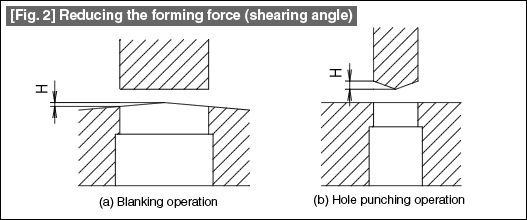Knowing the forming force necessary for carrying out a press blanking operation (shearing operation) is indispensable for selecting the press machine and for carrying out the die and punch design.
The blanking force (P) is obtained with the following equation.
|
However, when it is difficult to know the shear resistance (S), it is substituted by a value equal to 80% of the tensile strength (Ts) of the material. In this case the equation will be as follows.
|
Taking the example of Fig. 1, the blanking force will be as follows. The tensile strength of SPCC is taken as 30 kgf/mm2 in this case.
|

In order to reduce the blanking force, there is a method of providing a shearing angle as shown in Fig. 2. The shearing angle is provided in the die in the case of blanking operations and in the punch in the case of hole punching operations. Most often the shearing angle is provided so that the dimension H is roughly equal to or more than the plate thickness. By the way, the blanking force can be reduced by about 30% when the dimension H of the shearing angle is made equal to the plate thickness.

Technology News
- Preparing Compound Die Structures
- Blanking Force
- Capacity of Press Machine
- Die Height
- Method of Using Die Sets
- Bending Stamping Die Structure
- Die Structure---Blanking&Drawing
- Die Structure' Change Depending on the Guides
- Accuracy Judgment of Press Dies
- Plate Constitution of Stamping Dies
- Method for Compound Die Structures Preparing
- Design of Banking Dies Shape
- Basic Structures for Stamping Dies
- Tool Life of Stamping Dies
- Progressive Stamping Explaination
- What is Metal Stamping Tools
- Stamping Die Standard Parts Industry in China
- Main Operation Performed in a Stamping Die
- Clearance in the Blanking Procedure
- Punch and Die Disign for Punching Small Diameter Holes




